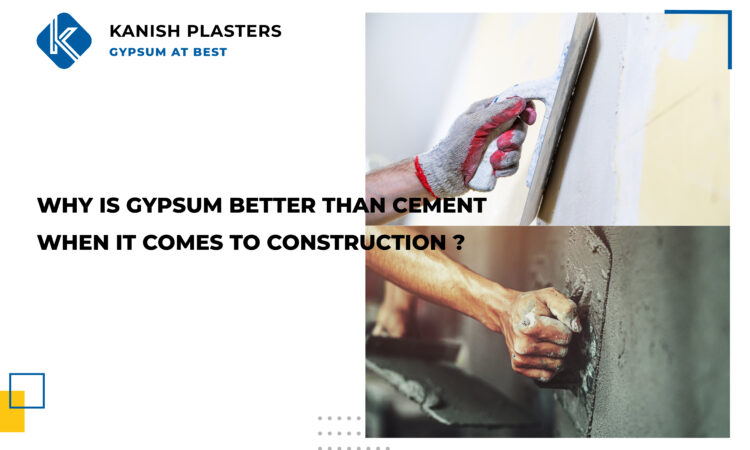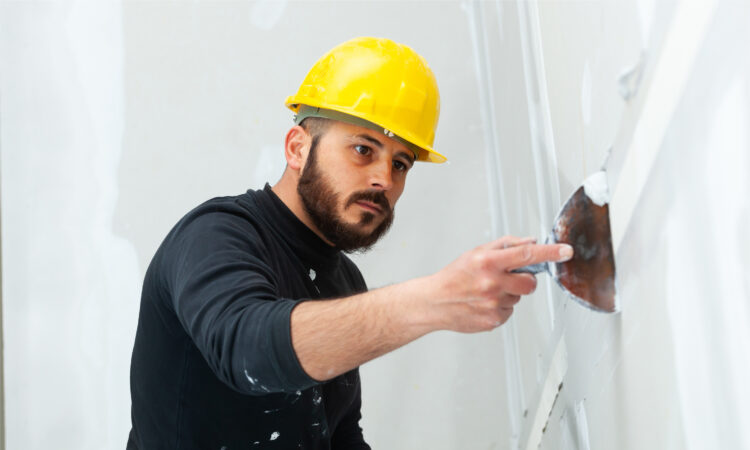Plaster in your building can protect and even contribute towards the beauty of the surface of the wall. There are three types of materials for plastering: Lime plaster, Cement plaster, and Gypsum plaster. Out of these, the most popular ones which are used during building construction are gypsum and cement plaster.
These plasters are not only used for internal plastering but also used in external plastering of the building. These plasters form a protective coating that covers brick and stone masonry and the RCC walls and ceilings. Plastering has been effective in equalizing the wall and ceiling surfaces. The materials such as cement and gypsum are also used to create textured plaster and finishes.
There are various advantages and disadvantages of Cement plaster as well as Gypsum plaster. Let us find out which one is most suitable as per your requirement. Below we have listed a few pros and cons of gypsum and cement plaster, kindly look through it for detailed information.
Cement Plaster
A cement plaster consists of Sand, Portland cement, and water. The mixture is homogeneous. Generally, a cement plaster thickens usually ranges between 12-20mm. The thickness depends on the category of wall or ceiling a surface that needs to be plastered.
Tip: The perfect mixture is obtained when you mix four parts of sand and water and one part of cement for plaster.
Advantages
- Cement plaster is highly moisture-resistant, unlike gypsum plaster.
- The first line of defence of the building against rain, wind, vehicular pollution, and harmful industrial gages is eternal cement.
- Using cement for plaster can be beneficial as you can use it for both internal and external walls and the ceiling of the building.
Disadvantages
- The result obtained by cement plaster is very rough and grey. To make it better, you need to treat the walls with Plaster of Paris punning. It makes the finish smooth before the application of wall paint. Punning is done by applying a thin layer of plaster or mortar to get a flat and smooth finish.
- The plaster made with cement has the tendency to shrink, which results in hairline cracks on the surface.
- You have to apply water to the cement plastered surface for at least seven days. This reaction of increasing the strength of the surface is called curing. Improper curing leads to wall cracks.
- Mould and mildew might attack cement plastered surfaces and walls.
Note: Give the plaster a time of three days to dry after curing. Once it is dried up, proceed for POP punning, followed by wall paint.
Gypsum plaster
The plaster made with gypsum is made in a factory, and unlike cement, these are white. It is available in powdered form, all you need to do is add the right amount of water, and it is ready to be directly used on your walls and ceiling surfaces. The approximate required thickness of gypsum plaster for walls is 11 millimetres and for the ceiling is 8 millimetres. Along with that, gypsum plaster can also be used to fabricate ceiling mouldings and cornices.
Advantage
- Gypsum plastered walls and ceilings are smooth and fine-level surfaces that make it easier and ready to receive paint. Therefore the additional cost of plaster of Paris that was going to be used and cement for cement plastered surfaces is reduced.
- It is very easy to prepare and use the paste for gypsum plaster compared to a mixture of cement plaster.
- Gypsum plaster is completely resistant to mildew and mould.
- Unlike cement plaster, gypsum plaster does not shrink as it does not expand or contract much.
- Gypsum is an eco-friendly product. It is considered a green product for the ability to be recycled an infinite number of times. It is made from the naturally found gypsum rock. It is completely dehydrated to produce a plaster powder. The paste is prepared by adding water to this powder. This plaster can be retrieved and recycled to powder once again.
- One of the biggest advantages of using gypsum is its ability to dry very fast. It hardly takes 24 hours to dry. On the safe side, it is advised to paint the gypsum plaster wall and ceiling only after 72 hours of its application.
- Gypsum keeps the building warm in winters and cold in summers. This happens because of the low thermal conductivity of the gypsum.
- Gypsum plasters are even fire-resistant.
Disadvantages
- Gypsum is best suitable for just the interiors of buildings and doesn’t cater to external plastering
- In moisture-prone areas like balconies, kitchens, bathrooms, or a damp basement, gypsum plaster usage isn’t recommended.
Thus, one can safely establish that gypsum has a better and superior finish compared to cement for the construction of internal ceilings and walls of a building.
Analysis
After learning all the aspects of Cement plaster and Gypsum plaster, it is visible that gypsum is a better material for your walls and ceiling. We will highlight some of the reasons you should keep in mind before choosing the material.
- Gypsum plaster saves construction time: It takes 21 days of curing when you use cement plaster, whereas gypsum does the work in just three days.
- Gypsum plaster has a lower impact on the environment: It is a naturally occurring substance and can be recycled repeatedly. It is not even a health hazardous substance; we are safe with the use of gypsum.
- Gypsum plaster incurs low water usage: As it does not require “curing”, a lot of water is saved when you opt for gypsum instead of cement.
- Elimination of shrinkage cracks: You might end up with wall cracks with sand cement plaster. Hence they use plaster of Paris. Whereas, gypsum gives you a completely fine and smooth finish to prevent cracks.
- The ease of application of Gypsum plaster is one of the most significant attributes of it.
- The construction of the building becomes lighter construction with gypsum plaster.
- With Gypsum plaster, there is a scope of Better heat insulation inside buildings.
- One can achieve the availability of better acoustics with Gypsum plaster.
If you are looking forward to making the walls and ceiling of your building more reliable with gypsum plaster, then Kanish Plaster Pvt. Ltd. is the company you need. It is the largest gypsum plastering applicator in Southern India. They will provide you workers along with the material for the best possible service. The company has secured 5-star customer satisfaction in 80% of its projects. Call them at 9994500474 to know more.
Read here: Top 5 benefits of gypsum plaster that every construction company must know



